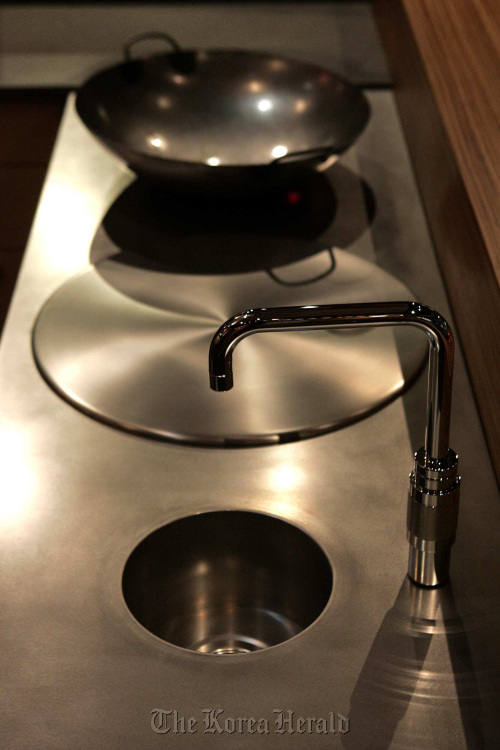To anyone reading the real estate ads in recent years, it could seem that granite was the only material worth using for a kitchen counter, as important as updated electrical or a reliable roof.
Granite isn’t going anywhere. But many designers and homeowners are turning to glass, manufactured stone, metal and other materials to create counters that work for people who actually cook as well for those who see the kitchen as a decorative accessory.
“What consumers now have seen is there is kind of this granite fatigue. Everyone has granite,” said Ed Rogers, the director of business development at CaesarStone US, based in Van Nuys, California.
CaesarStone and other brands, including Silestone, sell engineered quartz, a durable product made from more than 90 percent crushed quartz mixed with a resin.
Manufacturers are producing dozens of colors of engineered quartz, some of them trying to replicate the look of other stones or concrete, at prices comparable to those of midlevel granites. Both a virtue and a drawback is its consistency ― no fossils or natural quirks, though that could change too as companies work to mimic the natural variations of marble or add a leathery surface texture.
Glass counters too are shining. Lighted from below, they can add an appealing glow to a kitchen. Buyers also like the hygienic qualities of glass in these days of the hand sanitizer.
Granite had been “reserved for the ultra high end,” but now it’s available in big box home stores, Rogers said. “It was the home center and the production builder that moved this market.”
And moved some homeowners to other choices that are new and appealing to green consumers, such as engineered quartz, as well as some that have been around for centuries, like soapstone or marble.
 |
Stainless steel is one alternative to the ever-present granite countertop in a modern kitchen. (Los Angeles Times/MCT) |
“I have not done a single granite countertop in 10 years,” said Dan Campbell, a Los Angeles contractor who specializes in kitchen design and remodels. “Maybe because it’s so overused. It all blends together.”
Troy Adams also hasn’t used much granite in the high-end kitchens he designs, though he acknowledged there are many beautiful granite slabs available. Improvements to other materials, such as stainless steel with fine patterns that resist fingerprints, have made alternatives more popular, Adams said.
One of the materials he likes to use is lava stone, which is quarried from a volcano in France, enameled and then fired at high temperatures. It’s stain-, heat- and scratch-resistant, and it has a sort of crackly surface that can be made in intense colors. It’s also three to four times as costly as many granites, Adams said.
Whether the kitchen counter is just a spot to toss the keys and mail, the place for breakfast around an island, the lab for a chili cook-off entry or the respite for sitting alone with a glass of pinot grigio, the kitchen counter is inevitably a focal point of what’s become the center of many homes.
Adams said he builds his palette around the aspect of the kitchen with the most surface area, so a large, dramatic island might be the place to start.
In sophisticated, high-end kitchens, an island might be topped with one material, the sink and cooking area in another. In his own kitchen, Adams combined lava stone, stainless steel and glass.
That doesn’t mean the old standbys, including solid surfaces such as Corian, are gone from the market ― particularly in budget-minded kitchen plans. Wood ― often used for cutting blocks or other inserts to countertops ― also can work for counters, whether in a farmhouse kitchen in the city or a sleek contemporary space.
Although it still represents a small share of overall sales, engineered quartz has been the fastest-growing category in the last five or six years, CaesarStone’s Rogers said.
CaesarStone was the first engineered stone, made in 1987, said Arik Tendler, president of CaesarStone US. It was, and still is, made in Israel, where he grew up to become a stone fabricator.
When he was first approached by a salesman with engineered quartz, his reaction was: “Do me a favor. I’m a second-generation stone guy. Have some coffee and get out of here.”
Obviously, he changed his opinion over time. In Southern California, he went door to door to introduce his company starting in 1999.
Campbell said he likes the seamless counter front possible with engineered quartz. “No one wants to see the manufacturing of anything if you can avoid it,” he said.
Many companies also are working to make their products ― natural and manufactured ― as eco-friendly as possible. Consumers who care might check a product for its percentage of recycled materials, which varies considerably, or the conditions of its mining.
Cosentino reports that its Eco line is made of 75 percent post-consumer or post-industrial materials, including mirrors, glass, stone scraps and porcelain. Other counters are being made from recycled glass or recycled paper sealed with wax.
“Granite is going to stay as long as they keep on digging,” said Oren Osovski, an L.A. contractor and interior designer, noting that the range in appearance can provide a look that feels unique. “If you want something beautiful that only you have, you have to have granite or marble.”
By Mary MacVean
(Los Angeles Times)
(MCT Information Services)








![[Today’s K-pop] Blackpink’s Jennie, Lisa invited to Coachella as solo acts](http://res.heraldm.com/phpwas/restmb_idxmake.php?idx=644&simg=/content/image/2024/11/21/20241121050099_0.jpg)